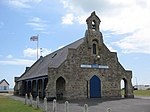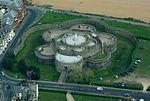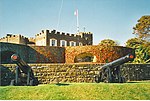Deal barracks bombing
1980s in Kent1989 in England1989 in military history1989 murders in the United Kingdom20th-century mass murder in England ... and 20 more
20th-century military history of the United KingdomAttacks on military installations in the 1980sBuilding and structure collapses in the United KingdomBuilding bombings in EnglandDeal, KentEngvarB from October 2013Explosions in 1989Explosions in EnglandHistory of the Royal MarinesMass murder in 1989Military actions and engagements during the Troubles (Northern Ireland)Military history of KentMurder in KentProvisional IRA bombings in EnglandRoyal Marines Band ServiceSchool bombings in EuropeSeptember 1989 events in the United KingdomTerrorist incidents in the United Kingdom in 1989Unsolved mass murdersUnsolved murders in England
The Deal barracks bombing was an attack by the Provisional Irish Republican Army (IRA) on the Royal Marine Depot, Deal, England. It took place at 8:22 am on 22 September 1989, when the IRA exploded a time bomb at the Royal Marines School of Music building. The building collapsed, killing 11 marines from the Royal Marines Band Service and wounding another 21.
Excerpt from the Wikipedia article Deal barracks bombing (License: CC BY-SA 3.0, Authors).Deal barracks bombing
Trafalgar Drive,
Geographical coordinates (GPS) Address Nearby Places Show on map
Geographical coordinates (GPS)
| Latitude | Longitude |
|---|---|
| N 51.213611111111 ° | E 1.4 ° |
Address
Trafalgar Drive
CT14 7FD , Lower Walmer
England, United Kingdom
Open on Google Maps









